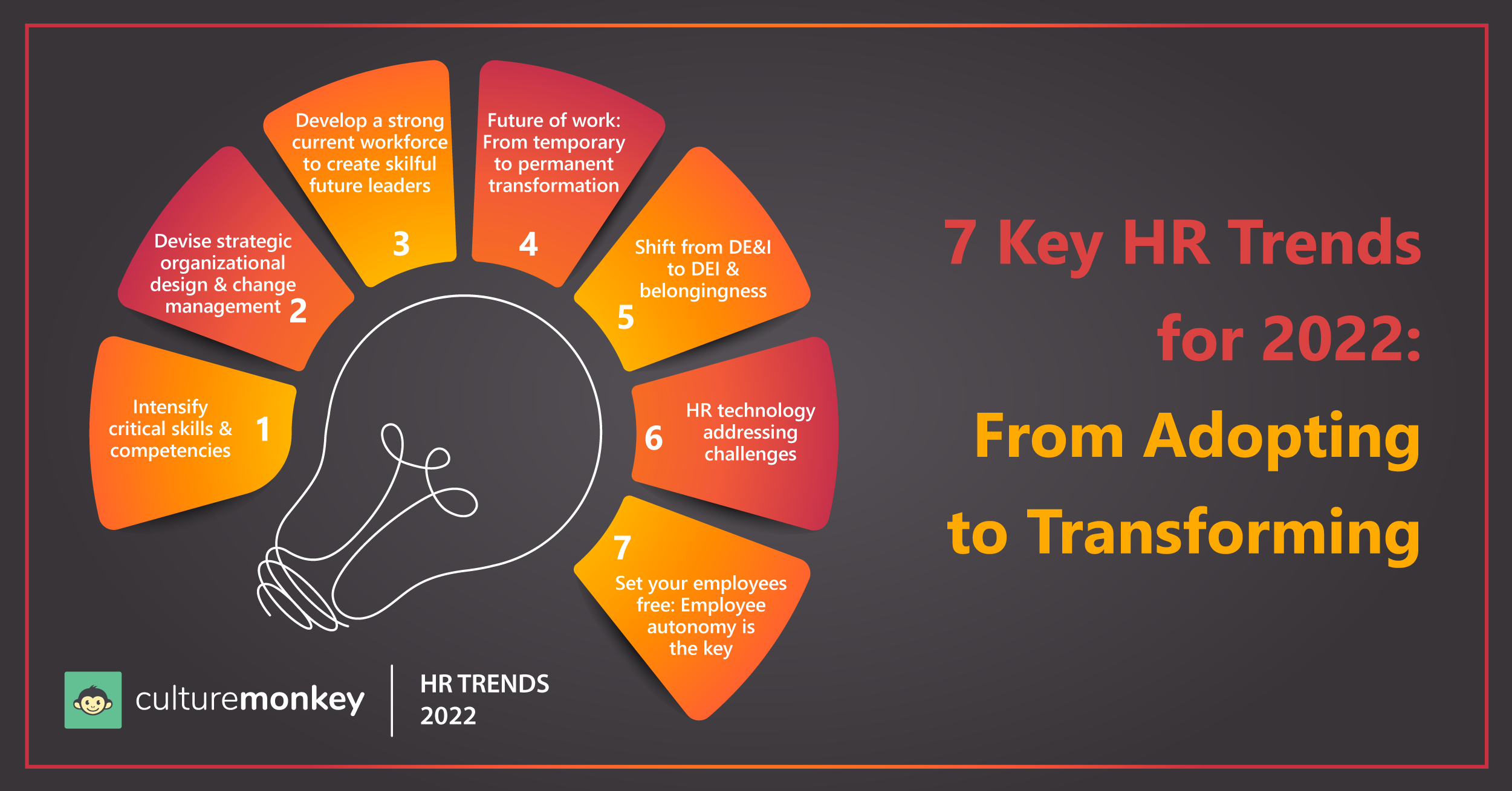7 key HR trends for 2022: From adopting to transforming

"Is Hybrid work driving business transformation?"
According to a Gartner survey, 90% of employees are expected to work remotely with a certain level of flexibility while 6% are expected to work in the office full time, besides the remaining 4% who will be expected to work fully remotely.
The statistics make it perceptible that the pandemic has left a lasting influence on the future of work. Every year leaders compile a list of HR trends to follow for organizations, to achieve success. But, in this article, we will not only update you on the latest trends but also identify gaps and propose solutions for managers to achieve excellence.
While HR leaders will considerably focus on enhancing operational excellence in 2022, enforcing business transformations is a close second, if we compare with 2021. In the previous year, with high levels of uncertainty, HR leaders ‘adapted’ to trends, as swift changes made them uncomfortable.
But, with normalcy returning, and people becoming comfortable with the idea of functioning regularly with COVID-19, HR leaders are now focusing on ‘transforming’ business policies and models towards a more permanent and flexible solution.

Employee experiences are ubiquitous and can cause business downfall if ignored.
But how do we make it better? Specifically, what HR trends to follow in 2022 to support success in the future of work?
There might be multiple trends you’d come across this year. But what’s important for leaders now is to understand the effect each HR trend will have on their organization’s operations and strategic goals.
We have curated a list of the top 7 trends for you that will have an everlasting impact on your business and can be achieved pretty quickly and efficiently.
HR leaders must:
1. Intensify critical skills and competencies:
According to Forbes research, some of the most impactful critical skills and competencies employees needed to excel in 2021 were effective communication, swift adaptability, dynamic problem-solving capabilities, and technical accuracy.
“40% of HR leaders find it difficult to build skill development solutions rapidly to support the fast-evolving skills needed in the organization” [Gartner]

Problem: It’s strenuous for human resource management teams to foresee skills their employees will need in the future to achieve organizational success. This often leads to incorrect investments.
Organizations might have their own shortcomings in arriving at accurate data when they try to study the products and solutions they market and link the entire analyses to the ecosystem they have built around operations and reporting tools.
Solution: To solve this in 2022, human resource managers will need to build a workforce around ‘skills’ and not ‘roles’.
Gartner TalentNeuron™ data shows the total number of skills required for a single job has been increasing by 10% year-over-year since 2017.
A company's strategic plan will be adaptable if they share ownership skills, compile dynamic skills data, and employ it wisely in talent decisions and management processes.
In cases where hiring trends have been uncertain due to the pandemic, and people analytics is off the charts, companies can deeply evaluate the skill set of their existing employees. Leaders should match employee skills to roles in demand besides training them to fill any gaps.
When reflecting upon skills adjacencies, HR leaders should do the following:
- Increase clarity on the current employee skill insights
- Identify and eliminate imperceptible skills adjacencies
- Modify career pathing systems to facilitate flexible career advancement
2. Devise strategic organizational design and change management:
It is essential to formulate strategic changes in organizations to align teams to new goals, objectives, and company culture and/or to eradicate old patterns hindering a team’s ability to achieve their objectives. Although it might sound easy, it is not a fail-proof process. There are certain risks associated with it, the biggest of all is to manage massive changes all at once.
"54% of HR leaders say their employees are exhausted from all the change." [Gartner]

Problem: Employees cannot cope with frequent changes which lead to lower innovations, collaborations, performance, and intent to stay.
Change fatigue magnetizes negative reactions such as burnout, frustration, or detachment which in turn leads to lower employee engagement and productivity. For instance, a large-scale organizational modification, such as a merger or acquisition, can be an imperative cause of change fatigue. If not addressed properly, this could create a retention issue amongst employees.
Solution: To succeed, bring about personalized and positive small day-to-day changes through your human resource management teams like shifting managers or office locations which will have a deeper impact on your employees. Measuring volume, exertion, and disruption through employee engagement surveys can help HR leaders to understand where to invest their time and energy and how to manage change while maintaining their company culture.
It is vital to create a close-knit environment to share common goals and create improved employee change experiences. As a leader, one should empower their teams to create and shape their own change experiences and pay close attention to the impact of change at each level that might get overlooked.
It is also essential to maintain workforce resilience by creating healthy environments and relationships and having a work-life balance alongside keeping the mental health of your employees in check.
HR trends to follow to reduce the risk of fatigue:
- Faith: Trust and inclusivity amongst employees are the bedrock of a company's success. Your employees must believe that leaders, managers, coworkers, and HRs have their well-being in mind, and will live up to their expectations. Employees who trust their employers and leaders highly possess the capacity to drive organizational change (regardless of the magnitude) greater than those who lack trust.
- Team cohesion: Team members who do not share a sense of belonging and connection face constant hurdles leading to setbacks and failure. Replicating best behaviors and creating shared experiences are significant for building camaraderie as per previous employment trends.
3. Develop a strong current workforce to create skillful future leaders:
Being able to choose and foster future leaders is extremely crucial for a company’s long-term health.
“47% of HR leaders said their organizations struggle to develop effective leaders, and 45% said their succession management processes didn’t yield the right leaders at the right time” [Gartner]

Problem: Employees tend to have trust issues with their managers and leaders due to lack of diversity in the system as found out through multiple employee engagement surveys.
The primary issue with creating a strong future pipeline despite having the most talented workforce is the poor transparency on career paths, extremely little access to senior leaders, and insufficient career support from mentors for the employees. On the other hand, HR leaders may fail to understand the future leadership roles and skillsets required in today's evolving and dynamic environments.
Solution: Building a workplace environment where managers empathize with their employees is critical as per HR trends 2022. Leaders should prioritize people over processes and embody a growth mindset.
Key points for talent acquisition managers to create a powerful future bench workforce:
- Strategic demand-driven planning instead of supply-driven planning: Hire employees based on organizational goals and strategies and not just based on current roles and vacancies.
- Define leadership positions across different skills: Mostly, each employees' growth mindset is aimed at the highest position in the hierarchy. Design and concentrate on developing leadership career paths around a few diversified experience requirements with different roles and positions in the option.
4. Future of work: From temporary to permanent transformation:
During the early stage of remote work adoption, organizations took small steps to bring about temporary changes in their strategies and policies. With the continuous effect on organizations, leaders have evolved their work models and revolutionized them into hybrid working styles. Change from office-centric models to human-centric models has become the future of work now.
Artificial intelligence and automation became a significant shift in the hybrid model. In this transition, many employees lost their jobs, while many got better roles. But, almost all transitioned into something different and underwent a change. With that said, companies are re-evaluating many aspects of work and transitioning from existing trends to more modern ones.
“49 % of HR leaders enunciate that they do not have a straightforward future of work strategy.”[Gartner]

Problem: COVID-19 pandemic has left organizations with an everlasting impact. The struggle for HR leaders is to figure out the magnitude of change they need to bring in their workplaces with pertinent employee feedback. Discerning between temporary and fixed modifications in strategic plans and goals has caused agony amongst talent heads.
Solution: To fix these issues, HR leaders must demarcate how a particular trend impacts the organizational structure, strategies, goals & company culture, and see whether it has a probable chance of creating a competitive advantage.
Evaluate the relevance, influence, and opportunity of a change as it is vital for workforce planning.
- Alter to a people-centric strategy, it will prompt productivity and employee engagement.
- Look at the future needs, and identify skill gaps to develop a single vision of the digital future.
- Assess weaker elements like employee work-life balance, job advancement opportunities, etc to build a future-ready workforce.
5. Shift from DE&I to DEI and belongingness:
Diversity, Equity, and Inclusion (DE&I) leaders entered 2020 with four foremost priorities creating a provision for HR issues -
- Ensuring diversity in hiring processes
- Mentor, develop, and promote talent diversity with equity
- Captivate senior leaders in DE&I strategies.
- Exclusion leads to team sabotage, creating a sense of belongingness is vital.
36 % of HR leaders say they struggle to hold business leaders accountable for DEI outcomes. [Gartner]
Social belonging is a fundamental human need, hardwired into our DNA. And yet, 40% of people say that they feel isolated at work, resulting in lower organizational commitment and engagement. [Harward business review]
Employees with higher workplace belonging also showed a 167% increase in their employer promoter score [Harward business review]

Problem: Employees acknowledge and understand the importance of DEI&B in a workplace, but there are very few efforts taken by individuals to change the environment, create a better future of work and instill more DEI&B strategies.
If we look at the statistics by Gartner, the percentage of women and racial minorities is extremely low at the C suite level.
Growth of marginalized talent stalls at the middle level. They experience dilatory rates of promotion and a worse foresightedness of leadership potential.
Solution: Leaders continue to steer through a world that is now fabricating a more purposeful effort to end systemic racism, social injustice, and inequality. Traditionally the problem lies in the fact that workplace inclusion policies remain to take a top-down approach. What can help address that challenge is an in-depth solution:
HR leaders must organize regular training programs targeting both awareness and development of behavioral and critical skills.
- Inculcate in the rewiring of human relationships, trust, and demeanors to develop deep insight into bridging skills and diversity gaps. This could be done through peer coaching or pulse surveys in order to comprehend the middle management conundrum. Use objective standards and data to drive unbiased talent decisions for meaningful outcomes for leaders.
- C-suite leaders can buffer the exclusionary behavior by treating everyone equally. To address the problem of exclusion, make employees adapt to new tools to gain perspective from mentors and leaders who are stepping up to create a sense of belongingness.
- Employee feedback is the cornerstone of an inclusive company. Regularly indulge in these practices to build inclusivity. Employees substantially hesitate to submit responses with utmost honesty on sensitive issues due to lack of trust and fear of negative implications.
To break the chain of poor culture, and bring belongingness in the workplace, leaders could use anonymous feedback and encourage two-way communications through detailed reports and manager dashboards.
Leaders and organizations must take it seriously to create a strong feeling amongst employees that they belong to an organization they value and hold the power to bring about change when needed.
6. HR Technology addressing challenges:
Across the world, companies have witnessed tremendous growth in technology, and HR tech has created opportunities forcing the companies to re-analyze how they incorporate processes and employee engagement. Determining change in the industry trends is crucial in today's ever-evolving work environment.
"85% of the employees want technology to help define their future and 75% would make life changes based on robot recommendations" [Tech Republic]
To which, "just 47% of respondents report that their organization is currently using some form of AI in their workplace and 31% say their company is not even discussing AI."

Problem:
HR leaders find it challenging to cope with the advancement in technology and use them in their day-to-day processes. They find the platforms cumbersome making it difficult to understand and analyze data and reports.
For organizations, infusing high-end technology is expensive and feels like an additional burden on the IT support team.
Due to incapabilities, HR leaders fail to keep their employees engaged and connected with these systems and are often grappling with HR AI and ethics. One use case of ethical bafflement is; Microsoft's face recognition tool has had the evidence of failing to recognize darker-skinned faces, with a 20.8% failure rate for darker-skinned 'female' faces.
Solution:
Technology can truly support connectedness in the realm of employee feedback and sentiment. Countless tools exist to elicit anonymous feedback and engage in honest conversations. Adopt flexible technology for your employees. Instead of a “push” mechanism, invite technology that has a “pull” mechanism, that is invited by your employees according to their needs, their skill set, and their end goals.
You can solve tech problems in your workplace by employing tools like pulse surveys to spot trends or aggregate feedback is paramount for specifying new challenges and acting on employee concerns.
- Keep an eye on tech burnout and bring employees under a common culture - connected and engaged.
- Make strategies that provide a framework for an AI ecosystem with solutions for emotional recognition.
- Train and educate HR leaders to identify biases and eliminate them timely to nurture a positive work environment.
Having a tech-friendly culture is essential to business growth. Seeking employee feedback on tech usability and understanding will give managers important intel on their future tech investments that will adapt to its people.
7. Set your employees free: Employee autonomy is the key
Intensified autonomy in workplaces for employee engagement can be a practical solution to reduce the disengagement rate for employees at work.
"51% of employees are disengaged in the workplace, while 13% are actively disengaged" [Gallup]

Problem: Managers who micromanage employees and scrutinize every action unceasingly find their employees disengaged with withdrawal symptoms. They debar from non-necessary conversations or activities and tend to only do the minimum to get by. Poor mental health decreases employee engagement, productivity, and motivation.
Disengaged employees cause financial losses to companies in the long run. On average, the aggregated revenue effect across organizations can add up to $500 billion every single year. But, the solutions to prevent this from happening are not so complicated. Just the right approach and culture can help companies reverse the effect.
Solution: Apple, for example, enunciated employees that they were expected back into the office at least thrice a week, which allegedly led to multiple resignations as employees expected autonomy and flexibility to decide their own working models.
To fix the challenge, organizations can:
- Constitute principles, not policies: Modifying from policies to principles, “minimum three days in the office per week” may alter to “we see constitutional value in both the physical workplace and remote locations — we dynamically foster employees to choose their own locations that support their efficiency to carry out certain tasks.” Principles can be equally operative as per employment trends while creating room to explore new ways of working.
- Implant agility and relatedness: To get the full benefit of autonomy, both agility and relatedness should also receive due attention and investment. Build a virtual-first company culture where employees have farsightedness to their role despite their location boundaries.
Create an ecosystem that connects employees with each other, professionally and socially to maintain high levels of cross functioning and collaboration. - Provide the right tool for efficient functioning: Nurture employees with the right tools and technologies to be sufficient, autonomous, and connected from anywhere. It is essential for you as a leader to invest in employee engagement software to understand employee needs.
Empower managers to address employee needs in time by utilizing the manager dashboard functionalities that provide timely actions, alerts, and nudges to mentors to listen to their employees and bridge gaps timely. It also gives employees the autonomy to select their way of working and managers could support them with the right principles and training.
HR Trends for Employee Engagement: What’s next?
The unconventional world of work requires HR leaders to view work, the workforce, and the workplace uniquely. Employee experiences and expectations are more significant than ever.

Leaders must exhibit perseverance, empathy, transparency, and digital literacy to assure each employee is engaged and has a voice in shaping the future of work. HR trends for 2022 are predominant to facilitating success for the business and its employees. Most HR leaders believe that improvising operational excellence will be vital in 2022. For every HR leader, the business transformation will be a benchmark of how their hybrid environments are built.
From CultureMonkey’s perspective, employee relationships and engagement are dependent on multiple factors. Diversions could arise due to personal and professional imbalance or faulty communication. Separate interests and objectives which should be tamed to equilibrium can cause disengagement.
In most common organizations, management asserts its authority and control downwards while work groups assert their independence and control upwards. Maintaining balance is imperative to stabilize the working environment. But, how can you measure that tipping point for your employees?
With CultureMonkey, you can create an emotionally safe environment for your employees and be mindful of their expectations to foster productivity.



